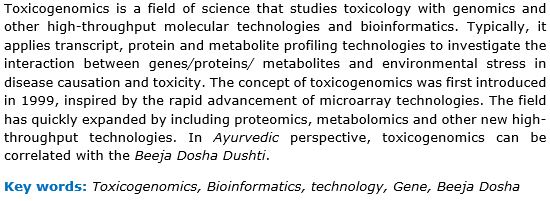A literature review on Toxicogenomics
DOI:
https://doi.org/10.21760/jaims.8.7.28Keywords:
Toxicogenomics, Bioinformatics, technology, Gene, Beeja DoshaAbstract
Toxicogenomics is a field of science that studies toxicology with genomics and other high-throughput molecular technologies and bioinformatics. Typically, it applies transcript, protein and metabolite profiling technologies to investigate the interaction between genes/proteins/ metabolites and environmental stress in disease causation and toxicity. The concept of toxicogenomics was first introduced in 1999, inspired by the rapid advancement of microarray technologies. The field has quickly expanded by including proteomics, metabolomics and other new high-throughput technologies. In Ayurvedic perspective, toxicogenomics can be correlated with the Beeja Dosha Dushti.
Downloads
References
Wills Q, Mitchell C. Toxicogenomics in drug discovery and development – making an impact. Atla Altern Lab Anim 2009; 37:33–7.
Nuwaysir EF, Bittner M, Trent J, Barrett JC, Afshari CA. Microarrays and toxicology: the advent of toxicog¬enomics. Mol Carcinog 1999;24(3):153–9.
Nuwaysir EF, Bittner M, Trent J, Barrett JC, Afshari CA. Microarrays and toxicology: the advent of toxicog¬enomics. Mol Carcinog 1999;24(3):153–9.
Koufaris C, et al. Hepatic MicroRNA profiles offer predictive and mechanistic insights after exposure to gen¬otoxic and epigenetic hepatocarcinogens. Toxicol Sci 2012;128(2):532–43.
Hoflack JC, Roth AB, Suter L. Toxicogenomics: a predictive tool in toxicology and drug development. Drug Metab Rev 2010;42:4.
Park HJ, et al. Identification of biomarkers of chemically induced hepatocarcinogenesis in rasH2 mice by tox-icogenomic analysis. Arch Toxicol 2011;85(12):1627–40.
Miao Q, Zhang CC, Kast J. Chemical proteomics and its impact on the drug discovery process. Expert Rev Proteomics 2012;9(3):281–91.
Beger RD, Colatsky T. Metabolomics data and the biomarker qualification process. Metabolomics 2012;8(1):2–7.
Bol D, Ebner R. Gene expression profiling in the discovery, optimization and development of novel drugs: one universal screening platform. Pharmacogenomics 2006;7(2):227–35.
Zhang T, et al. Recent progress on bioinformatics, functional genomics, and metabolomics research of cytochrome P450 and its impact on drug discovery. Curr Top Med Chem 2012;12(12):1346–55.
FDA guidance for industry, E16 biomarkers related to drug or biotechnology product development’ context, structure, and format of qualification submissions. August 2011 ICH.
Huang J, Shi W, et al. Genomic indicators in the blood predict drug-induced liver injury. Pharmacogenomics J 2010; 10:353–63.
Daston GP. Gene expression, dose-response, and phenotypic anchoring: applications for toxicogenomics in risk assessment. Toxicol Sci 2008;105(2):233-4.
Thompson KL, et al. Characterization of the effect of sample quality on high density oligonucleotide microar¬ray data using progressively degraded rat liver RNA. BMC Biotechnol 2007; 7:57.
Agnivesha, Charak samhita edited with Pandit Kashi Nath Shastri, Dr. Gorkhnath Chaturvedi, Chaukambha Bharti Academy Varanasi-221001, Reprint year: 2015, Sharir Sthana; Chapter 4; Verse 30,31; Pg. no. 877, 878
Sushruta Samhita, Kaviraj Ambikadutta Shastri edited with Ayurveda tattva sandipika Chaukambha Sanskrit Sansthan publishers Reprint: 2016, Sutra sthana; Chapter 24; Verse 6; Pg. no. 130
Sushruta Samhita, Kaviraj Ambikadutta Shastri edited with Ayurveda tattva sandipika Chaukambha Sanskrit Sansthan publishers Reprint: 2016, Kalpa Sthana.















